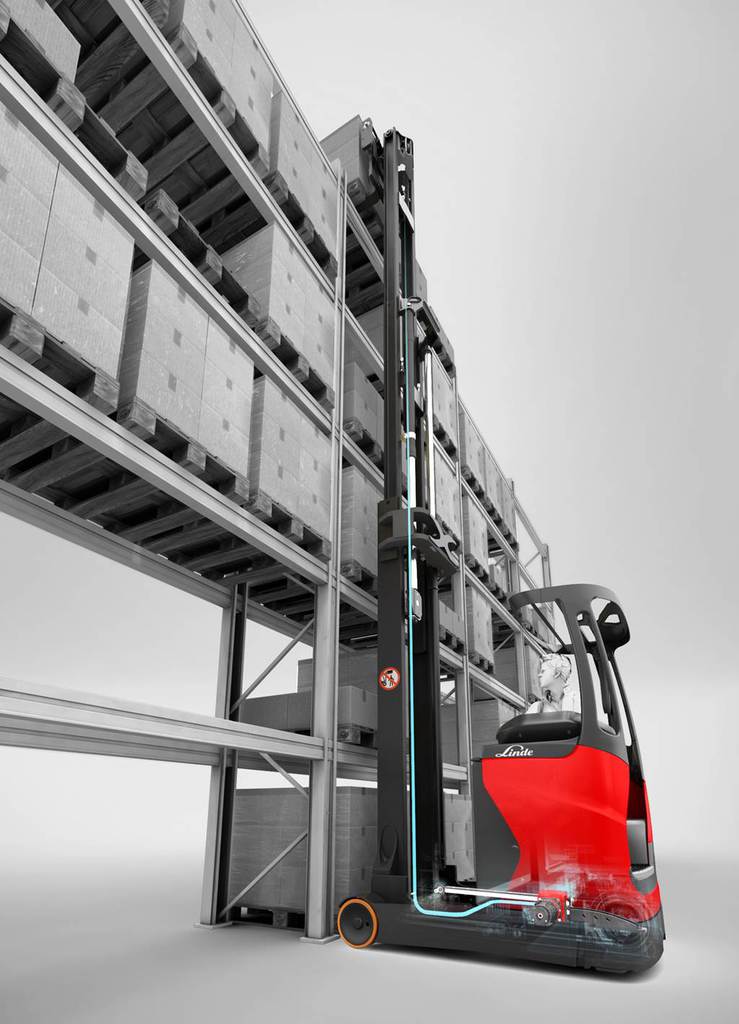

|
Edward Lowton
Editor |


|
| Home> | Handling and Storing | >Lift trucks & ancillaries | >Dynamic mast control |
Dynamic mast control
03 June 2015
Linde Material Handling (MH) will be introducing a new intelligent operator-assist system for reach trucks. Currently completing its final field test phase, the system will be available for the reach truck series Linde R14 – R20.

Alexander Schmidt, head of reach trucks & tractors Linde Material Handling, said: "The market trend for ever higher storage racks in warehouses and distribution centers is continuing apace. This means there is an increasing demand for reach trucks with lift heights of over 8m. While only 38% of all Linde reach trucks sold in 2005 were designed for such heights, this increased to 52% last year.”
However, higher lift heights place more demands on the skill of the operator. With the mast fully raised, the dynamic mast oscillations during reach movements are more pronounced particularly when laden. Furthermore, with the pallet load fully raised, the forward deflection of the mast increases.
When placing pallet loads onto a rack, the operator must first wait until the dynamic mast oscillations have ceased, because even with small oscillations it is difficult to position the load accurately into the rack location. This makes the operator’s task much more challenging and in the worst-case scenario, the load could damage the rack or displace the load stored behind. This eventuality could happen because the bigger the mast deflection, the more likely it is that the pallet load will be placed too deeply into the rack space and the load/pallet faces in the racking will therefore not be uniform along the aisles – the "chimney-effect” occurs.
At high lift heights, this non-uniform positioning of the pallet loads in the racking also makes it more difficult for the operator to retrieve goods efficiently. This is because the deeper the pallet load is placed into the rack the greater the center of gravity becomes. When the reach truck approaches a rack position to retrieve such pallet loads, it is not possible for the forks to be positioned completely underneath the pallet on the first approach. This means the operator has to bring the pallet forward slightly before lifting it off the rack and this increases the cycle times. In addition, there is a possibility that the deflection of the mast while lifting the pallet load from the rack could cause the pallet load to impact with the rack or with the load stored behind, especially if the load behind is also positioned too deeply.
Linde's new sensor-controlled 'Dynamic Mast Control' (DMC) operator-assist system for reach trucks provides highly effective support for the operator, providing a stress-free, and highly efficient working environment. Key to the system is a very precise electric linear actuator sytem in the reach truck’s motor compartment.
The Linde DMC system automatically compensates and minimises mast oscillations and mast deflection through precise and seamless counter-movements of the reach carriage – it does this rapidly with minimum use of battery energy. This means that the operator of a Linde reach truck fitted with DMC does not suffer the waiting times associated with mast oscillations and deflections and can therefore store pallet loads faster, accurately and more safely. Due to the accurate planning of the load, when retrieving a load, the forks will always be fully inserted into the pallet on the first approach. This results in faster cycle times, and the risk of damage to the rack or the load stored behind is virtually eliminated.
To control the dynamic oscillations and deflections of the mast as smoothly and effectively as possible, Linde MH opted for an energy-efficient electric linear actuator. An additional benefit is the simultaneous lift and reach feature without speed reduction, which enables increased productivity ratios to be achieved.

















